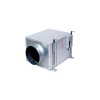I have that same tool ("Heavy Duty Hole Cutter"), I bought it to cut fan holes...
do not get it is all i can say.
Took me about 20 mins to get through 9mm of MDF, and it's so messy and unstable to use by hand, I ended up having to buy a new panel and use my jigsaw.
My Hand-held Drill didn't have enough torque to cut larger holes with this, even my big mains powered one bounced about every now and then, but I must stress that it's very unstable and hard to do a good job with it by hand...
This attachment is more suited to those big heavy duty drills on stands, found in workshops ect.
For fan holes, Solid Ducting and other lil jobs like that you should have a look at 'Oscillating Multitools', they're great!
Got one a while back, now i only need to use my Jigsaw for long straight cuts or thick beams.
Anyway, I checked in here with some soundproofing advice, but felt compelled to share my waste of money with all, and hopefully save you all some cash!
-----------
I've been a sound engineer for the past 7 Years and have even taken part in a few commercial studio constructions...
During this time I have worked and spoken with many Acousticians and Specialist Contractors, so without being up my own ass... I do know what I'm talking about when it comes to Sound!
The number one rule you need to know about sound insulation is that it's all about the Frequencies!
Let's not make this too much of a Sound Engineering lesson, but basically we mainly want to concentrate on the Lower-Mid to Upper Frequencies, as fan noise is most resonant in this range.
Egg Crate type insulation can help, just like acoustic/foam padding, and actual insulation...
That's all good, but the number one thing you can do, is concentrate on the construction of the walls of your cab/room ect.
The key to Blocking Sound is to have a solid surface for the sound to hit, then a hollow space, followed by another solid surface (hope that explains it).
That doesn't mean that you can insulate a cab or a fan with 2 layers of 3mm plywood!!
here is what I have done from inside out:
3mm MDF board Sandwiched onto a 9mm MDF board with 'Green Glue' (a bit expensive, but if you apply it as per the instructions, a tube will go further than you might think. I used less than 1).
This already gives me 2 hard surfaces with a gap inbetween.
Then on the other side of the support frame, I have 12mm MDF board covered with some light carpet (heavy duty is best for sound, but not great for temps), as carpets are often used to control High Frequencies. Put on with Staple Gun a tiny bit of Green Glue of course

(Love that shit!).
Outside was filled in with good old wood filler, then painted.
If youre dealing with an actual room, make a frame all around your room and put some Drywall/Plasterboard on the outside and MDF or something inside (Plasterboard is better than MDF, but will degrade if it gets wet so should not be used for the inside).
You don't need to shrink your space or spend £$£$ lol, a single layer of 12mm MDF framed up about 2 inches away from your actual wall will do wonders!
A cubic foot or two of space are worth the peace of mind in my eyes...
For an actual interior door, you can use screws in the corners, all screwed to leave an inch or 2 sticking out. Then simply push MDF board up to it and crew it to the door, this will leave the all important gap, whilst not adding too much weight to the door, as I've seen a Studio Door practically remove fingers! :S
Unless you spend a shitload of cash, there will always be some noise... especially as inputs and ouputst are a fact of life for us.
All i can hear from my grow which is near where I sleep, is a gentle hum from Airflow... and as far as that goes, Blowing through Oversized Carbon Filter with Solid Ducting is what will make the most difference (In my opinion).
I can sleep no worries, and with my headphones on but no music playing, I can't hear it!
Hope this helps anyone having issues...
Remember that the planning stage is the most important... and Green Glue is awesome!
Zip.










